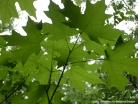


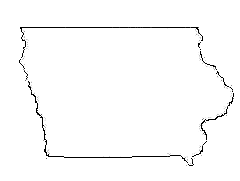
Home>Browse by State>Iowa
The Hawkeye State, 'Our liberties we prize and our rights we will maintain'
Iowa

Want to add your tree to our picture gallery? Click here for details!
-Color denotes a tree that is rare or endangered

We are part of the Hubpages community.
Click here for more info.
Click here for more info.
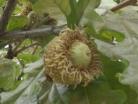
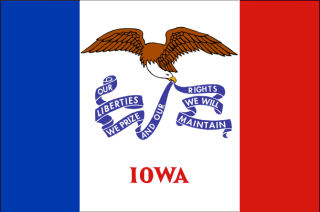
Native Trees of Iowa
Recreation in Iowa often means heading
to one of the many lakes for swimming, fishing, hiking
or learning about the rich Native American area
history. The landscape not only allows for the well
known farm lands responsible for feeding so many,
but has prairies, canyons, bluffs, and rolling hills,
which support an outdoor adventure for any skill level.
As you wind your way through the many miles of
maple, hickory, and oak lined trails, you may stumble
across one of the numerous caves in Iowa. For the
avid cave explorer, Maquoketa Caves State Park has
more caves than any other Iowa State Park. Landbridges, streamside forests of ash and
basswood, nature centers, Native American burial mounds, a 'walk under' prairie, interpretive
trails- even one dedicated to 40 species of lichen- await visitors of Iowa's State Parks.
The many lakes of Iowa, in particular the 'lakes area' of northwest Iowa, offer year round
activities including swimming, boating, fishing and hiking on the miles of paved or rugged trails.
Spirit Lake is actually the largest natural lake in Iowa. With fish like bluegills, bullheads,
crappies, catfish, muskellunges, northern pike, perch, smallmouth bass, and white bass,
fishermen and families come from miles around to enjoy the peaceful environment or have
lunch. Not only are there hickory and oak trees to picnic under here, it is estimated that 2 out
of every 100 trees in Iowa is a black walnut. In fact, Iowa has the highest concentration of
black walnut trees anywhere in North America. Because of this, black walnuts are the black
gold of Iowa as they are an integral part of the state's timber industry. Also high in numbers
are Ash trees. There are approximately 50 million ash trees within the state so it is no wonder
the threat poised by the Emerald Ash Borer is a concern for the overall forest and urban tree
health. Trees attacked by the EAB will die within 2 years and any nearby ash trees should be
expected to die within 6 years as the non-native pest spreads.
Iowa also has the distinction of being the only state bordered by two navigable rivers. This,
combined with the many lakes, allows for Iowa to have marshlands, flood plains, high bluffs,
rocky cliffs like those found in 'The Backbone', and 150 million year old exposed river beds.
There are many parks set aside by the state for exploring the geological and natural wonders,
and horehounds in search of the state stone, the geode, will delight at the chance to find some
at Geode State park- just don't take anything out of the park!
Autumn in Iowa ranks high on the beauty scale as the forests are mostly deciduous. The

State Tree: Oak

The oak tree became the State Tree of Iowa in 1961 as a symbol of strength. There are 12 species of oak trees native to Iowa including pin, swamp white, black, red, chinkapin, blackjack, post and bur. Oak trees an important part of the ecosystem as a variety of wildlife feed on the acorns. Oaks are also an important timber species.
Oak trees typically grow 80 feet tall and may have a trunk diameter between 2 and 4 feet, though many trees grow wider or taller. Often planted in parks for their attractive shape, foliage, and shade, oak trees are one of the top amenity trees. They do best when given ample space to
Oak trees typically grow 80 feet tall and may have a trunk diameter between 2 and 4 feet, though many trees grow wider or taller. Often planted in parks for their attractive shape, foliage, and shade, oak trees are one of the top amenity trees. They do best when given ample space to
grow and should be planted away from structures as their roots may disrupt foundations.
Common characteristics to all oak trees are lobed leaves and acorns. The number of leaf
lobes can vary and red oak species will have leaves with a small prickle on the lobe tip.
Acorns size, shape, and color is as diverse as the genus- some are round while others are
slender and some are black, brown, or any color in between. Acorns can be barely nestled
inside their cap or almost completely engulfed by it like the Bur Oak.
Bur Oak, Quercus macrocarpa, Bicentennial
Oak in Plano, Tx. Bob Woodruff Park.
©2012 TreesForMe Original Image.
See usage requirements.
Iowa Native Tree Facts

Forested acres: 3 million
Percent of total area forested: 8%
Largest Trees in Iowa: Eastern Cottonwood, Populus deltoides
Most Valuable Timber Tree: Black Walnut
Number of National Forests: 0
Number of State Parks/Forests/Recreational Areas: 68
Number of Tree city USA communities: 92
Number of invasive tree species: 26 (see state list for noxious/invasive plants)
Insects of Concern: Emerald Ash Borer, Gypsy Moth
Pathogens of Concern: Bur Oak Blight, Thousand Canker Disease
Number of tree families in our collection: 25
Number of endangered or threatened species in our collection: 3
Sources:
Arborday.org
US Forest Service
Iowa Association of Naturalists
United States Department Of Agriculture, Natural Resources Conservation Services: PLANTS Database
Additional state resources:
Iowa State Parks
Iowa Department of Natural Resources: Forest Health
Iowa State University, Forestry Extention
Percent of total area forested: 8%
Largest Trees in Iowa: Eastern Cottonwood, Populus deltoides
Most Valuable Timber Tree: Black Walnut
Number of National Forests: 0
Number of State Parks/Forests/Recreational Areas: 68
Number of Tree city USA communities: 92
Number of invasive tree species: 26 (see state list for noxious/invasive plants)
Insects of Concern: Emerald Ash Borer, Gypsy Moth
Pathogens of Concern: Bur Oak Blight, Thousand Canker Disease
Number of tree families in our collection: 25
Number of endangered or threatened species in our collection: 3
Sources:
Arborday.org
US Forest Service
Iowa Association of Naturalists
United States Department Of Agriculture, Natural Resources Conservation Services: PLANTS Database
Additional state resources:
Iowa State Parks
Iowa Department of Natural Resources: Forest Health
Iowa State University, Forestry Extention
Iowa Native Tree Families and Genera

click to enlarge.
Useful information while browsing species:
• How to read a botanical name
• How to use our species boxes:
• How to read a botanical name
• How to use our species boxes:
-Color denotes a tree that is rare or endangered
Please note: This is not a complete list of all native tree families and species found in Iowa. We are constantly working towards a more comprehensive list and will add families and their species as completed.
Additional Resources:
North American Native Tree Families
North American A to Z List by Scientific Name
North American A to Z List by Common Name
North American Native Tree Families
North American A to Z List by Scientific Name
North American A to Z List by Common Name
Follow the links to view species native to Iowa. If the genus is not linked, species are listed on the family page.
Aceraceae, Maple
Annonaceae, Custard-apple
Betulaceae, Birch
Betula, Birch
Carpinus, Hornbeam
Corylus, Hazelnut
Ostrya, Hophornbeam
Bignoniaceae, Trumpet Creeper
Caprifoliaceae, Honeysuckle
Cornaceae, Dogwood
Cornus, Dogwood
Nyssa, Tupelo
Cupressaceae- Cypress
Juniperus, Juniper
Thuja, Arborvitae
Ebenaceae, Ebony
Diospyros, Persimmon
Aceraceae, Maple
Annonaceae, Custard-apple
Betulaceae, Birch
Betula, Birch
Carpinus, Hornbeam
Corylus, Hazelnut
Ostrya, Hophornbeam
Bignoniaceae, Trumpet Creeper
Caprifoliaceae, Honeysuckle
Cornaceae, Dogwood
Cornus, Dogwood
Nyssa, Tupelo
Cupressaceae- Cypress
Juniperus, Juniper
Thuja, Arborvitae
Ebenaceae, Ebony
Diospyros, Persimmon
Fabaceae, Pea
Fagaceae, Beech
Quercus, Oak
Hamamelidaceae, Witch-hazel
Hippocastanaceae, Horse-chestnut
Juglandaceae, Walnut
Carya, Hickory
Juglans, Walnut
Lauraceae, Laurel
Magnoliaceae, Magnolia
Moraceae, Mulberry
Oleaceae, Olive
Fraxinus, Ash
Pinaceae, Pine
Abies, Fir
Pinus, Pine
Fagaceae, Beech
Quercus, Oak
Hamamelidaceae, Witch-hazel
Hippocastanaceae, Horse-chestnut
Juglandaceae, Walnut
Carya, Hickory
Juglans, Walnut
Lauraceae, Laurel
Magnoliaceae, Magnolia
Moraceae, Mulberry
Oleaceae, Olive
Fraxinus, Ash
Pinaceae, Pine
Abies, Fir
Pinus, Pine
Platanaceae, Plane-tree
Platanus, Sycamore
Rosaceae, Rose
Crataegus, Hawthorn
Prunus, Plum/Cherry
Rubiaceae, Madder
Rutaceae, Rue
Salicaceae, Willow
Populus, Cottonwood
Salix, Willow
Tiliaceae, Lindon
Tilia, Basswood
Ulmaceae, Elm
Celtis, Hackberry
Ulmus, Elm
Platanus, Sycamore
Rosaceae, Rose
Crataegus, Hawthorn
Prunus, Plum/Cherry
Rubiaceae, Madder
Rutaceae, Rue
Salicaceae, Willow
Populus, Cottonwood
Salix, Willow
Tiliaceae, Lindon
Tilia, Basswood
Ulmaceae, Elm
Celtis, Hackberry
Ulmus, Elm
Iowa Endangered or Threatened Tree Species

Definition of status (per Iowa DNR website):
Special Concern- any species about which problems of status or distribution are suspected, but not documented. Not protected by the Iowa Threatened and Endangered Species law, but many animal species listed as Special Concern are protected under other state and federal laws addressing hunting, fishing, collecting, and harvesting.
Special Concern- any species about which problems of status or distribution are suspected, but not documented. Not protected by the Iowa Threatened and Endangered Species law, but many animal species listed as Special Concern are protected under other state and federal laws addressing hunting, fishing, collecting, and harvesting.
Threatened:
Fraxinus quadrangulata- Blue Ash
Salix lucida- Shining Willow
Endangered:
Prunus nigra- Canada Plum
Fraxinus quadrangulata- Blue Ash
Salix lucida- Shining Willow
Endangered:
Prunus nigra- Canada Plum
Looking for a nursery near you?
Check out our nursery listing by county below!
Sorry, we do not currently have any tree nursery listings for this state. We do update these lists, so please check back.
Check out our nursery listing by county below!
Sorry, we do not currently have any tree nursery listings for this state. We do update these lists, so please check back.


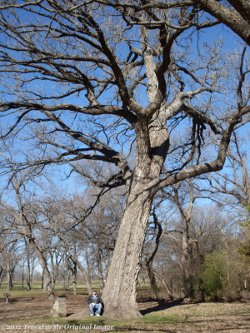
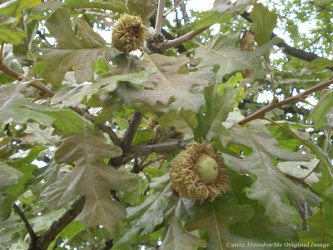
Bur Oak, Quercus macrocarpa, acorns
©2012 TreesForMe Original Image. See usage requirements.
Threatened Species- any species which is likely to become an endangered species in the future throughout all or a significant portion of its range. Protected by law.
Endangered Species- any species of fish, plant life, or wildlife which is in danger of extinction throughout all or a significant part of its range. Protected by law.
Endangered Species- any species of fish, plant life, or wildlife which is in danger of extinction throughout all or a significant part of its range. Protected by law.
Special Concern:
Abies balsamea- Balsam Fir
Acer spicatum- Mountain Maple
Amelanchier alnifolia- Saskatoon Serviceberry
Amelanchier sanguinea- Roundleaf Serviceberry
Asimina triloba- Pawpaw
Crataegus chrysocarpa- Fireberry Hawthorn
Crataegus chrysocarpa var. Chrysocarpa- Red Hawthorn
Crataegus disperma- Spreading Hawthorn, Two-fruited Hawthorn
Crataegus pruinosa- Waxyfruit Hawthorn
Prunus hortulana- Hortulan Plum
Sassafras albidum- Sassafras
Viburnum prunifolium- Blackhaw
Abies balsamea- Balsam Fir
Acer spicatum- Mountain Maple
Amelanchier alnifolia- Saskatoon Serviceberry
Amelanchier sanguinea- Roundleaf Serviceberry
Asimina triloba- Pawpaw
Crataegus chrysocarpa- Fireberry Hawthorn
Crataegus chrysocarpa var. Chrysocarpa- Red Hawthorn
Crataegus disperma- Spreading Hawthorn, Two-fruited Hawthorn
Crataegus pruinosa- Waxyfruit Hawthorn
Prunus hortulana- Hortulan Plum
Sassafras albidum- Sassafras
Viburnum prunifolium- Blackhaw
summer green changes to red, orange, yellow and gold and gives bikers of the 50 mile Lake-to-Lake State Park Bike Route a more enjoyable experience. Iowa is also one of the best places for equestrian trail riding. Almost every park has equestrian friendly trails, some specifically for equestrian use only, and allow for scenic views of sweeping prairies, bluffs along the Mississippi river, or the quiet forest while ducking under sugar maple and basswood branches. Eventually, anyone riding or hiking through Iowa's woodlands will marvel at the state's tallest trees, eastern cottonwoods. During winter, cross-country skiing is a favorite past time in Iowa and the few conifers native to the state keep a touch of green year round.

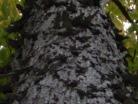
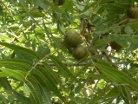
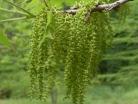
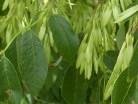
Tree lists:
•A-Z by scientific
name
•A-Z by common
name
•By Family
For state A-Z list click state name below.
•A-Z by scientific
name
•A-Z by common
name
•By Family
For state A-Z list click state name below.


™

Monday, May 19, 2025
|
|
|
|
|
| A-Z scientific | ||
| A-Z by Common Name | ||
| Families | ||
| Browse by State | ||
| Rare or Endangered Species | ||
| Trees_with_Special_Uses | ||
| Tallest and Biggest |
| Aceraceae Maple Family | ||
| Anacardiaceae Sumac Family | ||
| Annonaceae Custard Apple Family | ||
| Aquifoliaceae Holly Family | ||
| Arecaceae, Palm Family | ||
| Betulaceae Birch family | ||
| Bignoniaceae Trumpet Creeper Family | ||
| Burseraceae Frankincense Family | ||
| Caprifoliaceae Honeysuckle Family | ||
| Chrysobalanaceae Coco-plum Family | ||
| Cornaceae Dogwood Family | ||
| Cupressaceae Cypress Family | ||
| Cyrillaceae Cyrilla Family | ||
| Ebenaceae Ebony Family | ||
| Ericaceae Heath Family | ||
| Fabaceae Pea Family | ||
| Fagaceae Beech Family | ||
| Hamamelidaceae Witch Hazel Ffamily | ||
| Hippocastanaceae Horse Chestnut Family | ||
| Juglandaceae Walnut Family | ||
| Lauraceae Laurel Family | ||
| Leitneriaceae Corkwood Family | ||
| Magnoliaceae Magnolia Family | ||
| Meliaceae Mahogany Family | ||
| Moraceae Mulberry Family | ||
| Myricaceae Bayberry Family | ||
| Myrsinaceae Myrsine Family | ||
| Myrtaceae Myrtle Family | ||
| Nyctaginaceae Four Oclock Family | ||
| Olacaceae Olax Family | ||
| Oleaceae Olive Family | ||
| Pinaceae Pine Family | ||
| Platanaceae Plane Tree Family | ||
| Polygonaceae Buckwheat Family | ||
| Rhamnaceae Buckthorn Family | ||
| Rosaceae Rose Family | ||
| Rubiaceae Madder Family | ||
| Rutaceae Rue Family | ||
| Salicaceae Willow Family | ||
| Sapindaceae Soapberry Family | ||
| Sapotaceae Sapodilla Family | ||
| Simaroubaceae Quassia Family | ||
| Styracaceae Storax Family | ||
| Symplocaceae Sweetleaf Family | ||
| Theaceae Tea Family | ||
| Tiliaceae Lindon Family | ||
| Ulmaceae Elm Family | ||
| Taxaceae Yew Family | ||
| Yucca Family |
| Maple A-Z |
| sumac_family_a-z |
| custard_apple_family_a-z |
| holly_trees_a-z |
| palm_family_a-z |
| birch_family_a-z |
| trumpet_creeper_family_a-z |
| honeysuckle_family_a-z |
| dogwood_family_a-z |
| cypress_family_a-z |
| heath_family_a-z |
| pea_family_a-z |
| beech_family_a-z |
| walnut_family_a-z |
| magnolia_family_a-z |
| olive_family_a-z |
| rose_family_a-z |
| willow_family_a-z |
| franklinia |
| elm_family_a-z |
| Federal List | ||
| State Lists | ||
| Invasive_species |
| Restoration of the American Chestnut | ||
| Restoration of the American Elm | ||
| Sustainable Forestry |
| Contact Us | ||
| Our Contributors | ||
| Photo of the Month | ||
| Usage Requirements | ||
| FAQ | ||
| Report a Broken Link |
| photo_submission |
| Photo Store |

Custom Search




